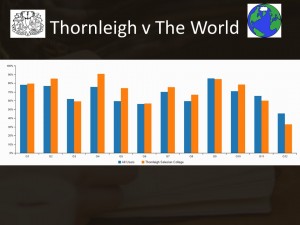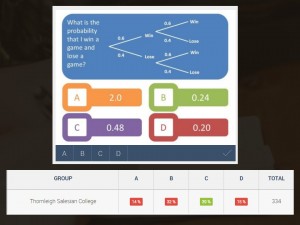What misconceptions do students have with tree diagrams involving independent events and decimals?
Essential Skills Quiz 8 has once again revealed some fundamental misconceptions our Year 11 students have with key areas of mathematics. Topics that teachers (myself included) may have been tempted to gloss over, or leave out completely, are catching our students out. Often they are the kind of concepts that students should have learned 5 years ago, and which eat into valuable teaching time in these vital final months. If we can address them efficiently and effectively now, both as a maths department and with our students, hopefully all misconceptions will be resolved by the time of the exam, and we can focus our attention on teaching the more difficult topics.
Quiz 8 is below, followed by an analysis of the Insight of the Week. Looking at the questions in the quiz, can you guess what the worst answered questions were?
Here’s how our students performed compared to the rest of the world:
Our students struggled with equations of straight line graphs and laws of indices. But one question in particular gave them no end of trouble – one featuring a lovely tree diagram:
Only 39% of our students got this question correct, with B being the most popular incorrect answer, but A and D also tempting a significant number of them. Before reading their explanations, can you guess why students may have gone for each of the incorrect answers?
Now, during the process of creating Diagnostic Questions, and especially in recent months as the number of students’ answers and explanations has grown (there are now over 2.5 million), I have become increasingly aware that my prior assumption that students either could or could not do a topic in maths was completely wrong. Worse, it was damaging. Often, students cannot do topics for a number of fundamentally different reasons. And the specific mistake they are making, or the misconception they are holding, dictates the type of support they need.
This has rarely been more apparent than in the question above on Tree Diagrams.
The students who have got the question wrong have done so for very different reasons. Reading your students explanations will reveal exactly where in the process students are going wrong, and that will help you work with them to resolve their problems,
Let’s take a look at how our lot got on and see if there are parallels with your students:
Incorrect Answer A (14% of our students chose this)
Students selecting this option have no problem interpreting the question and selecting exactly which branches they need. Their misconception lies in dealing with the decimals. For some students it is not knowing that you multiple when going across a tree diagram, and for others it is realising that they need to multiply in the first place, but then carrying out this operation incorrectly. Their explanations makes this crystal clear.
“you could win first and then lose which is 0.6×0.4 which is 1 and then you could lose and then win which is 0.4×0.6 which is 1 and then you need to add them together which is 2.0”
“0.6 times 0.4 is 1 and then you do it again to get 2”
“0.6 + 0.4 = 1.0 0.4 + 0.6= 1.0 2.0”
Incorrect Answer B (32% of our students chose this)
Here we have a different misconception. Students choosing this answer may understand that need to multiply when travelling across a tree diagram, and also are competent in multiplying 0.6 by 0.4. However, their problem comes understanding that there is more than path to the desired outcome. Is this because of an ambiguity in the way the question is asked? Possibly, but I have certainly seen this mistake countless numbers of times over the last few years, and it needs addressing head on.
“Probability of winning a game is 0.6. The probability of losing a game is 0.4. If you want one to happen AND the other to happen, you need to multiply, which gives 0.24”
“I multiplied the probabilities together to get the answer (0.6×0.4)”
“i think this is the answer because 0.6×0.4=0.24”
Incorrect Answer D (15% of our students chose this)
Now I found this fascinating. Students opted for an answer of 0.20 for a number of different reasons, many of which I would not have considered. Have a read of the following:
“Because I took 0.4 from 0.6 which gives me 0.2 or 0.20”
“because 0.20 is the difference between the two chances”
“There are two chances of winning and loosing”
“0.6+0.4= 0.10 0.4+0.6= 0.10 0.10+0.10=0.20”
The Correct Answer!
One of my motivations for developing Diagnostic Questions was so that students all around the world could learn from each other. When your students finish a quiz, please encourage them to review their answers, reading through other students’ explanations, until they find the magic one that makes sense to them. And just as importantly, please encourage your students to write good explanations – they will be helping out students from all around the world, and each time their explanation is liked, the score valuable points on the site. So, what are our Year 11 students’ favourite correct explanations to help them resolve their own misconceptions?
“There are four possible outcomes (win+win, win+lose, lose+win, lose+lose). Two of these outcomes give one win and one loss. Probability of a win+lose= 0.6 x 0.4 = 0.24. Probability of a lose+win = 0.4 x 0.6 = 0.24. Because you want the probability of a win+lose or a lose+win, add these probabilities (if its an ‘and’, e.g. win AND lose, times them; if its an ‘or’,e.g. win+lose OR lose+win, add them) for your final answer: 0.24 + 0.24 = 0.48.”
“You can win the game first and then lose so the probability would be 0.6x .04= 0.24. But you can also lose the game first and then win the seond game so the probability would be 0.4 x 0.6 = 0.24. You add them together and you get a probability of 0.48”
“You go along the win, lose branch and multiply 0.6 by 0.4 And then you go along the lose, win and do exactly the same. Then add the totals”
Tackling the Misconception in Class
Each week we discuss the Insight of the Week in our Monday Maths Departmental Meeting and try to come up with strategies for tackling it when we next see our lovely Year 11 classes. Here are a few suggestions we came up with, depending on which particular misconception our students had:
- Students who selected A need convincing that probabilities cannot be greater than 1. It is an interesting exercisd to ask a group of students how they would continence someone that probabilities can never be greater than 1.
- It is clear from this question that for many students it is operations with decimals that are more of an issue than probability. If that is the case then we need to go back to basics with multiplying and adding decimals before continuing with tree diagrams. The same is true for tree diagrams involving fractions – there is no point taking them on until the fundamental skills of fractions are in place
- Some teachers explained that they would ask their students to covert these decimals to fractions as students found them easier to deal with
- Another colleague always writes multiplication signs between the branches to remind her students which operation is needed to get across the tree diagram
- Writing the events at the end of each particular path (eg Win, Lose) may help students understand exactly what is happening
Please add any extra ideas in the Comments section below!
The series of GCSE Essential Skills Quizzes are available here and will always be completely free.
Quiz 9 is available here
I hope these quizzes will prove useful to help your students develop the essential skills necessary for success at GCSE, and aid your teachers gain a deeper understanding of how your students learn.



The nice way of looking at this is “multiply across to get AND” (i.e. Win AND Lose or Lose AND Win) then “add top to bottom to get OR” (i.e add the Win/Lose OR Lose/Win outcomes) to get final answer of 0.48.
The really difficult concept in this field is a little further down the line, the application of these rules in Independent/Dependent or Exclusive/Mot Exclusive situations -but thats another story!
I’d just like to say thanks for the huge amount of hard work that has gone into producing the quizzes and data based on student responses. I am not even a maths teacher, but have beceom more and more interested over the months in a) seeing how well I would do myself in answering the questions, b) understanding how students misunderstand, and c) seeing which way they jump. Fascinating insight into numeracy and maths teaching, and I wish I were teaching maths. now. Keep it up – I am sharing it with anyone I know who may be interested. What you are doing is what teaching should be about – sharing and caring about real learning.
Thanks so much for your kind words – they mean a lot! Craig